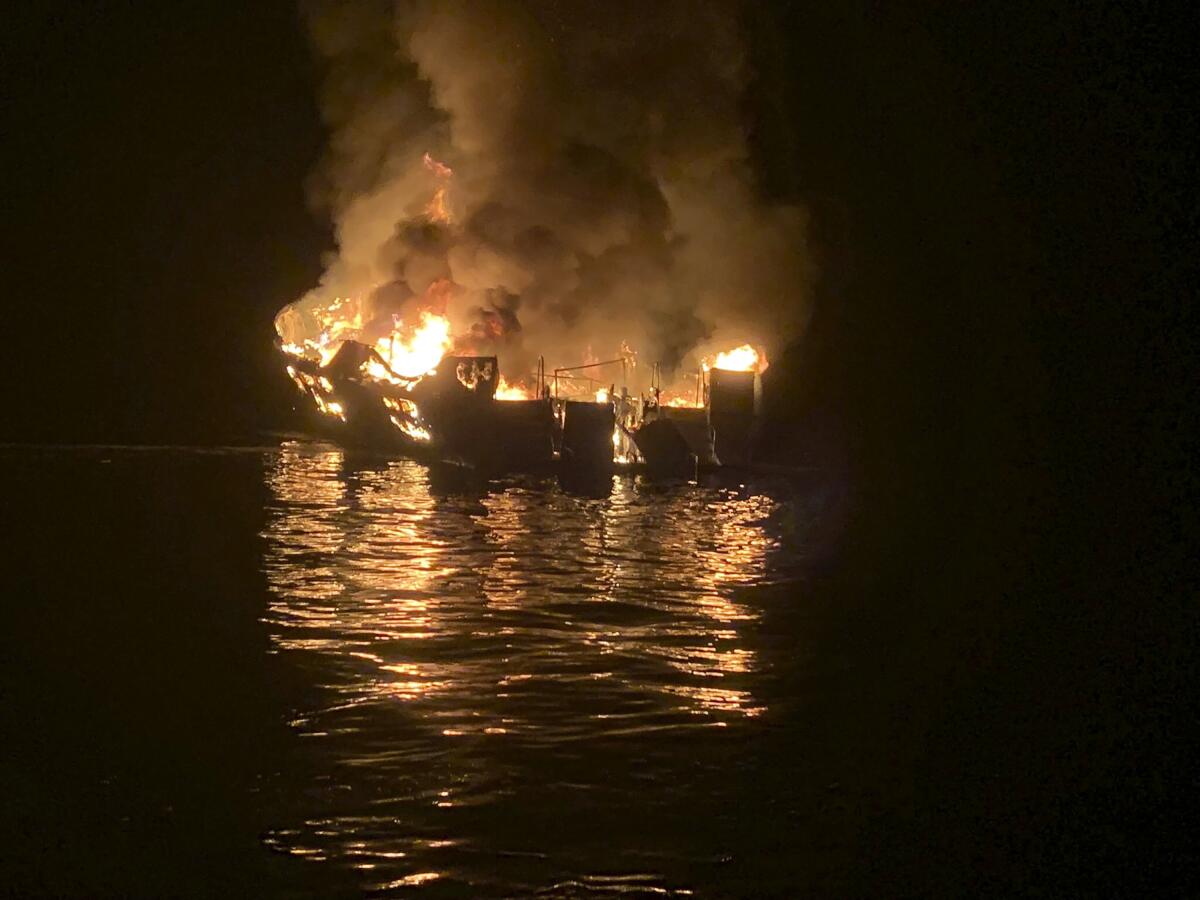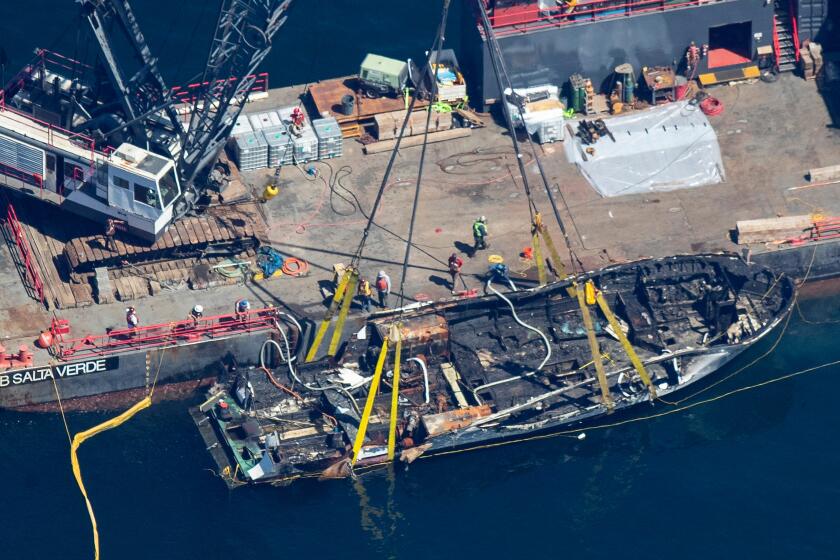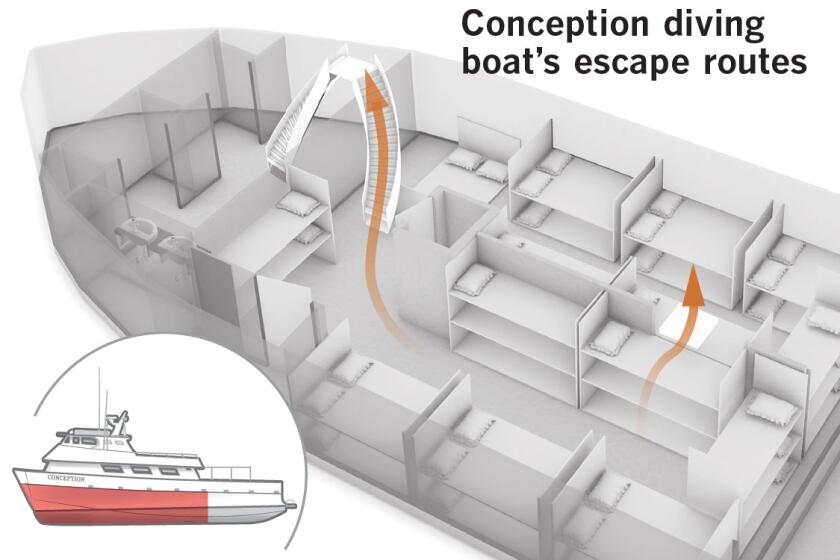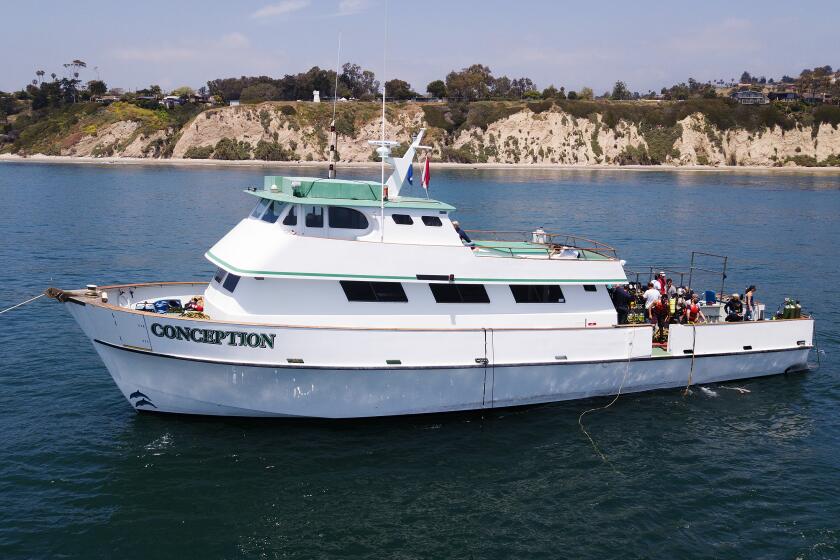Was the California boat fire a crime? Investigators search for answers

- Share via
On Monday, about 15 federal agents were examining the Truth, a vessel similar to the Conception, at the Santa Barbara Harbor.
Both the Conception, where 34 died in a fire a week ago, and the Truth are owned by the same company, Truth Aquatics, which has come under growing scrutiny.
Agents were on all levels. Several were looking at the ladder going from the galley deck to the wheelhouse. Others were lifting up compartment covers and taking notes.
Law enforcement sources say the federal investigation — which includes the FBI, Bureau of Alcohol, Tobacco, Firearms and Explosives, and the U.S. Coast Guard — is trying to determine whether any crime occurred in the worst maritime disaster in modern California history.
The fire broke out during a Labor Day weekend diving expedition, trapping the victims, who were sleeping below deck. Five crew members who were above deck at the time were able to escape and said the fire was too intense to get anyone else out.
Here is what we know now:
What is the latest in the investigation?
On Sunday, agents served warrants at the Santa Barbara headquarters of Truth Aquatics seeking training, safety and maintenance records.
Investigators took photos and boxes during the search, which is part of the ongoing investigation into the incident, said Lt. Eric Raney with the Santa Barbara County Sheriff’s Office. No arrests were made.
A commercial diving boat caught fire near the shoreline of Santa Cruz Island, Calif., early Monday. Many aboard the boat were believed to be sleeping below deck when the fire broke out in the pre-dawn hours.
What have investigators found so far?
Law enforcement sources told The Times last week that a preliminary investigation into the Conception boat fire had suggested serious safety deficiencies aboard the vessel, including the lack of a “roaming night watchman” who is required to be awake and alert passengers in the event of a fire or other dangers.
The probe also has raised questions about whether the crew was adequately trained and whether passengers received a complete safety briefing, said the sources, who spoke on the condition of anonymity because they did not have approval to comment publicly about the case.
What laws are involved here?
A federal law dubbed “seaman’s manslaughter” was used last year in Missouri by federal prosecutors to charge a duck boat captain and two others in connection with the loss of 17 lives when the amphibious craft capsized in a storm . In that case, it was Coast Guard investigators who built the case for criminal negligence. The captain is accused of failing to assess the weather, steer the vessel appropriately and prepare the passengers for abandoning ship.
Authorities have not suggested the fire and fatalities aboard the Conception were the result of any criminal wrongdoing, but prosecutors from the U.S. attorney’s office in Los Angeles were at the scene on Thursday preparing to assist investigators and keeping tabs on the unfolding inquiry.
The Coast Guard has said the Conception had passed all recent inspections.
What do we know about the minutes after the fire broke out?
A source familiar with the crew’s accounts told The Times that hours before the fire erupted, the passengers had participated in a night dive. A crew member who had been straightening up the galley and mess area went upstairs to the wheelhouse about 2:35 a.m.
Before the crew member went upstairs, he checked to make sure the stove was cold and flammable materials were stowed, according to the source, who was not authorized to comment publicly and spoke on the condition of anonymity.
Sometime before 3:15 a.m., the crew member heard a noise and thought someone on the boat had tripped. The flames prevented him from getting into the galley, the source said. The passengers and one crew member were in the sleeping area one level below the galley.
During the questioning with National Transportation Safety Board investigators, crew have speculated that the fire began in the seating area of the galley.
“The galley area was engulfed in flames,” NTSB commissioner Jennifer Homendy said, recounting what the crew member told investigators. “They tried to enter through the double doors but couldn’t get in because of the flames. They tried to access the galley from the front through the windows, but the windows wouldn’t open.”
A boater who helped the surviving crew members that morning said one of them thought the fire started in the galley, where cellphones and cameras had been plugged in to charge overnight.
Authorities have not said whether the investigation so far has pointed to either a specific location or a cause. But the source said that based on the crew’s account, the fire did not start in the Conception’s engine room.
The NTSB said one of the crew members who escaped didn’t hear any smoke detectors going off.
The Conception, where 34 people were killed in California’s worst maritime fire in recent history, was a “compliant fire trap,” one expert said.
What do we know about the victims when the fire started?
Authorities believe the victims died of smoke inhalation.
There were two ways out from the sleeping area: a staircase and an emergency hatch. It is possible both were blocked by flames.
Homendy said she was “taken aback” by the small size of the emergency hatch when she toured the Vision on Wednesday with a team of investigators.
She and the investigators turned the lights off to see what it would have been like for the passengers trapped on the Conception. Getting to the emergency hatch was difficult, she said, adding that they couldn’t find the light switches in the dark.
“You have to climb up a ladder and across the top bunk and then push a wooden door up,” she said. “It was a tight space. We couldn’t turn the light on.
“It surprised me how small it was and how difficult it was to access,” she said about the escape hatch. “I couldn’t see the people in front of me.”
More to Read
Sign up for Essential California
The most important California stories and recommendations in your inbox every morning.
You may occasionally receive promotional content from the Los Angeles Times.















